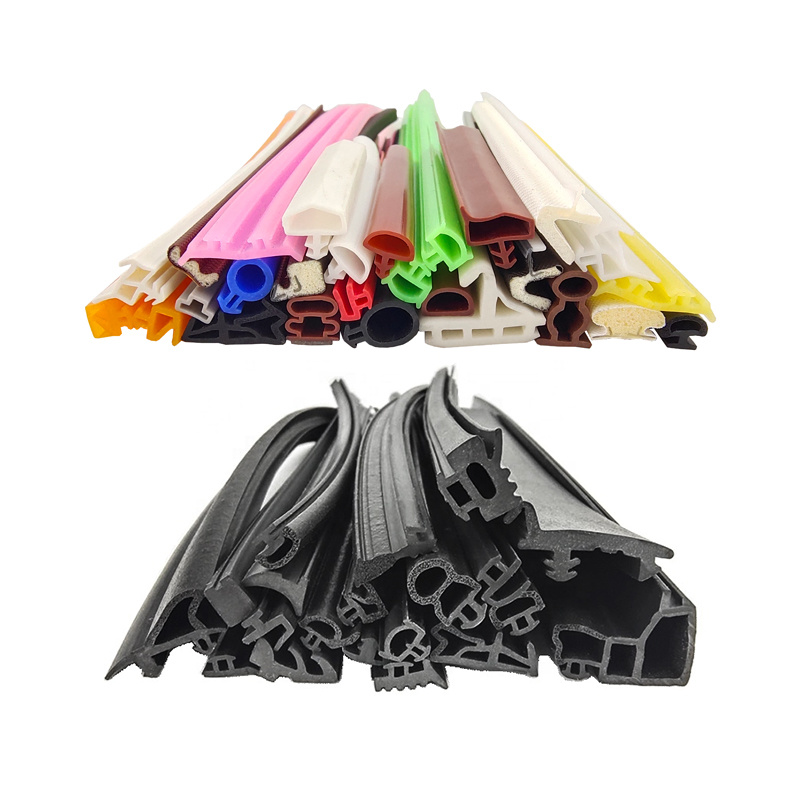How to Choose the Right Material for Door & Window Seals
2025-09-08

**How to Choose the Right Material for Door & Window Seals**
Selecting the correct seal material is crucial for the performance of your doors and windows. It directly impacts **air tightness, water resistance, thermal insulation, noise reduction, and durability.** The wrong choice can lead to drafts, dust, noise, and higher energy bills.
**1. Common Seal Materials & Their Properties**
Here are the most prevalent materials used for door and window seals:
**a. EPDM (Ethylene Propylene Diene Monomer) Rubber**
* **Characteristics:** The **industry gold standard** for high-performance applications. It offers exceptional weather resistance (to heat, cold, ozone, and UV radiation), excellent elasticity, and a long service life (often 10-15 years).
* **Pros:**
* **Superior Sealing:** Excellent compression set recovery, ensuring long-term protection against air, water, and dust.
* **Thermal & Acoustic Insulation:** Very effective for energy saving and noise reduction.
* **Durable & Eco-friendly:** Highly resistant to aging and is typically non-toxic and odorless.
* **Cons:** Higher cost than basic materials like PVC.
* **Best For:** **Almost all residential and commercial applications,** especially high-end aluminum windows, thermal break windows, and system windows. **The top recommended choice.**
**b. PVC (Polyvinyl Chloride)**
* **Characteristics:** A **low-cost plastic-based** material. It is inexpensive to produce.
* **Pros:** Very low cost, widely available.
* **Cons:**
* **Poor Durability:** Becomes hard and brittle over time (often within 1-2 years) due to plasticizer migration. Loses elasticity, leading to cracking and failure.
* **Poor Eco-profile:** Can contain plasticizers and emit odors, especially in heat. Performs poorly in cold temperatures.
* **Best For:** Low-budget, temporary solutions, or low-performance windows. **Not recommended for long-term home use.**
**c. TPE/TPV (Thermoplastic Elastomer / Thermoplastic Vulcanizate)**
* **Characteristics:** A **high-performance, recyclable alternative** to EPDM. It combines the processing advantages of plastics with the elastic properties of rubber.
* **Pros:** Good elasticity and weather resistance, eco-friendly (recyclable, odorless), soft tactile feel.
* **Cons:** Generally more expensive than PVC, less market recognition than EPDM.
* **Best For:** A modern, sustainable choice for mid-to-high-end windows and doors. Commonly used in automotive sealing.
**d. Silicone Rubber**
* **Characteristics:** **Excels in extreme temperature resistance.** Can be formulated to be food-grade.
* **Pros:** Outstanding high and low-temperature resistance (-60°C to 200°C), non-toxic, odorless, and highly flexible.
* **Cons:** Lower mechanical strength (abrasion resistance) compared to EPDM, and **significantly more expensive.**
* **Best For:** Specialized applications like industrial ovens, appliances (oven doors), and extreme environments. **Rarely used for standard windows due to its high cost.**
**e. Foam Rubber (Sponge EPDM/Neoprene)**
* **Characteristics:** A **soft, compressible** material with a closed-cell structure, often based on EPDM or CR (Chloroprene).
* **Pros:** Excellent for filling large and irregular gaps due to its high compressibility.
* **Cons:** The surface can be less durable and more prone to wear and tear than solid rubber.
* **Best For:** **Installation seals** (between the window frame and the wall), secondary sealing, or as a filler for very uneven surfaces.
---
**2. Key Selection Criteria: A Step-by-Step Guide**
Follow these steps to make the best choice:
1. **Prioritize Material (Choose EPDM):**
* For **long-term performance and value**, **choose EPDM rubber seals**. The higher initial cost is offset by their longevity and energy savings.
* If **budget is the primary constraint** and performance is secondary, PVC might be considered, but expect to replace it sooner.
* For a **modern, recyclable option**, look for TPE/TPV seals.
2. **Check Brand & Manufacturing Quality:**
* Opt for seals from **reputable manufacturers** (e.g., Hebei Fengming ). They use high-purity compounds and consistent processes.
* Avoid products made from **recycled or unknown compounds**, which may have a strong odor, poor elasticity, and a short lifespan.
3. **Test Feel and Recovery (Compression Set):**
* **Squeeze it:** A high-quality seal will feel **soft yet tough**. When you compress it and release, it should **spring back to its original shape quickly** with no permanent deformation.
* **Poor-quality seals** will feel hard, crumbly, or too soft, and will recover slowly or not completely.
4. **Examine the Profile and Surface:**
* Look at the cross-section. It should be consistent, with **no voids, pits, or irregularities**.
* The surface should be **smooth and uniform**, not dull, dusty, or rough.
5. **Consider the Installation Type:**
* **Push-on/Clip-on Seals:** Ensure the internal spine (usually a metal or plastic insert) is strong enough to hold the seal firmly in the channel without twisting or falling out.
* **Self-adhesive Seals:** The **quality of the adhesive is critical**. Look for strong, pressure-sensitive acrylic adhesive (like 3M VHB tape) that can withstand temperature changes and humidity without failing.
6. **Evaluate Your Environment:**
* **Cold Climates:** EPDM or Silicone are essential, as they remain flexible at very low temperatures. PVC will become hard and ineffective.
* **Sunny/Hot Climates:** EPDM's superior UV and ozone resistance prevents cracking and degradation.
* **Coastal/Humid Areas:** EPDM and Silicone offer excellent resistance to moisture and mildew.**Summary & Quick Recommendation**
**Final Advice:**
For the best balance of performance, longevity, and value, **invest in high-quality EPDM rubber seals** from a trusted supplier. This small component is vital for your home's comfort, efficiency, and quietness.
Previous:
The next one:







